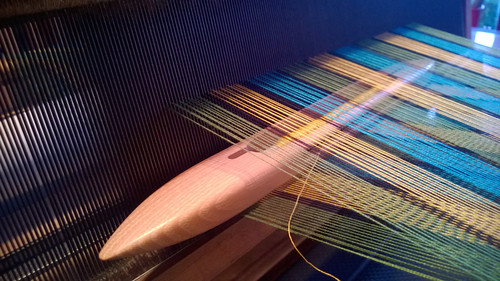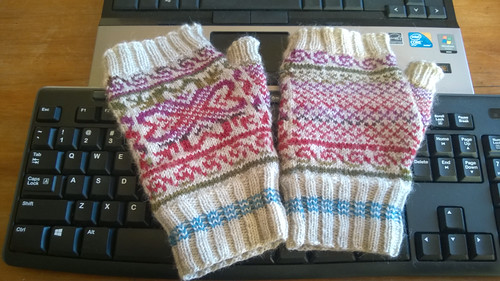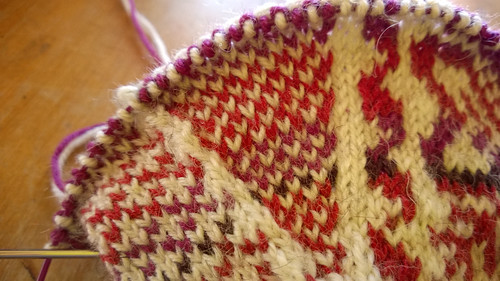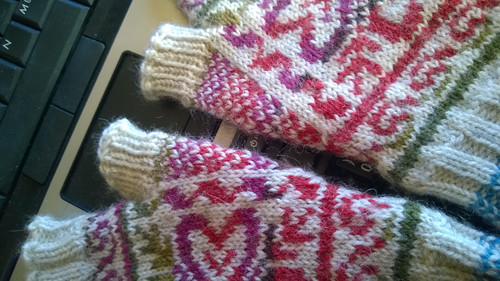When I started to get serious about knitting, to go beyond what was on offer in the local shops and printed patterns, when I became dissatisfied with the patterns in the library books and bookshop books ... I knew what I was doing and why. There was a baby on the way, he is 15 going on stroppy now, but back then he was an unknown thing. All I knew as I wanted to look after him - and for me, with my family upbringing that mean making stuff. So I made stuff - all sorts of stuff, I sewed sheets to fit the refurbished bassinet, and then to fit his cot, I knit things, and later we made food, cooked carrots and rice in preference to buying jars of commercial food.
When I went to knit for my baby, way back then in the dark ages of pre-2000, there were two kinds of baby knitting, or at least there seemed two kinds of baby knitting. I could knit pretty lacy baby layettes, seemingly unchanged since 1900. Cute lacey bonnets, with matching bootees and matinee jackets, in fine 2 or 3 ply yarn, in pale colours like white, lemon, and mint. Or I could knit bright chunky 80's themed boxy sweaters and vests. There seemed little in between. Now I know there were heaps of things out there - but here in the Southern Hemisphere on the other side of the globe - here seemed little else. What I wanted to knit was cute traditional sweaters, in nice colours that were in scale with my baby, If adults wore hand knits knit on 4-5mm needles, then it seemed right that babies wore smaller versions knit on 2-3mm needles, the ribbing and details needed to be scaled down. I found online knit groups, found Elizabeth Zimmerman, found her EPS and began. I never looked back, and discovered that knitting need not be the commercialized kit set yarn and pattern combinations on offer from branded yarn companies. In hindsight I understand the reasons that companies offer what they do, the market and the amount of time and skills of their customers are part of the system they work with. I knew what I wanted from knitting and didn't feel restricted by local offerings,
When I began to spin, I knew again what I was wanting to achieve, I had followed knit blogs for many years, and watched the rise of knit groups online that included nods towards spinning. I saw the amazing yarns being created, I saw amazing things being knit from those yarns and I wondered if being able to spin might answer my supply issues. I still lived in the same place, the baby was older and had a sibling, but the local yarn shops seemed the same, the same thick yarn, intended to be knit on the same largish needles, and following the same conventional patterns. I had discovered online shopping, but also that what arrived in my mail box wasn't quite what I had thought would arrive. And buying online and getting things shipped cost a lot. So I built a spindle, then bought a wheel, then another and another, and spun. At some point early on I realized that there was little connection between what I spun and what I knit, it that seemed less important as I had discovered there was a rhythm and zen to spinning that I enjoyed. I knew why I began, and I knew why I continued, and I was guided by knowing why.
Fast forward to nearly now, and weaving. Some months ago I helped a student set up and use a rigid heddle loom, all the while while explaining that whilst I knew how to do this, I really had not found any joy in weaving. I wondered if not touching the yarn was the missing element, and thought weaving wasn't tactile enough. After helping the student I wondered if I tried my four shaft table loom if I would like it more, I did try and I did like it, so much so that I now have a floor loom, a table loom, a new hobby and I'm enrolled in two weaving workshops. And it's not even four months later.
Weaving I have discovered is a tactile process, it's just the touching happens in different ways to when knitting and when spinning. The yarn or thread is handled a lot when one prepares the warp, and when the loom is dressed, and even when the weft is wound on bobbins - then it is the loom that is touched not the yarn, the loom is touched the most when weaving. The shuttle is used, the beater and the treddles or lifts are worked - while the yarn stays untouched. And before the weaving there is planning and measuring, there are calculations, how long, how many, and these are calculations that should be carefully done if a finished peice is to look planned. In a kind of way the yarn is mentally touched. After the planning the warp is fitted to the loom, and each thread carefully threaded through a path that makes the pattern intended. That is more touching of yarn and loom. In this case a monks belt pattern, which I think is variations on squares, for a weekend workshop next week. I may have bitten of more than I could manage.
You see with knitting you can fudge a lot, as I tell littlest cub when she knits, if you finish a row and there are not the right number of stitches, look at the row and if it looks ok just knit a few together or make a few secretly on the next row to even it out. Not so much with lace ...and some other techniques, but in the beginning you can fudge it quite a bit. With spinning the same thing, if it spins up thicker, or thinner - slow down and see what you have when you finish - it will be useful and will look 1000%better when you knit it up than it did on the bobbin. Pretty much all yarn can make a hat, or a pair of mitts or wristers or even an ugly blanket for the cat to sleep on.
With weaving - not so much, if something is threaded the wrong way, in the wrong place or wrong order - it shows. See the threads here, how evey so many two are lifted - well if there were three or none where you expected two - it would be noticed. And that is difficult to hide. I threaded and re threaded three times - each time 334 threads to get this to this stage. And the irony is that I should have only had 332 threads but I couldn't count properly, and couldn't easily think how to deal with the extras so left them there, my pattern wouldn't be symmetrical. By the time I found I had extras I gave up, my weaving won't be symmetrical, but the pattern should work,
This is where I would discover the error, once everything was threaded, tied, and tensioned, when I wove the 'heading', I'd see three threads where two should be ......
So I'd start again, I'd check to see if the mistake was fixable easily, and each time the answer was not. To sort the mistake I had to unthread half the threads and work out towards the side again. I couldn't switch two threads over, or slide a heddle into palce, so I would undo, and be even more careful, count, and thread and check and repeat.
Which is where I have been for the past week, wondering what it is about weaving that makes me want to do this, to put myself through this. I'm not a careful planning check and count person - so I'm surprised that I'm working on this and undoing things and spending days correcting errors, and beyond that I'm planning to do this again and again. I think it's about being able to - but I'm not sure. There is a an incredible sense of satisfaction when it is all set up and works - and maybe as a mechanics daughter that ticks a box that needs ticking, problem solving and making it work as a whole. Maybe a loom set up and ready to weave on is like an engine in perfect tune, balanced and magic in the working.
But - I don't know why I'm doing this, and why I want to do more of this thing that requires me to be more careful than I've ever been. And that kind of bewilders me, not bothers, not worries, but has me wondering what is the drive this time.
Oh and little cub and I are knitting socks, she knits one, I knit the other and we swap occasionally. Dr who tardis socks - details to follow. Deadline -school camp in three weeks. Underneath is some unwashed spinning, four skeins of three ply - 300g, as before - details to follow.
Na Stella





























